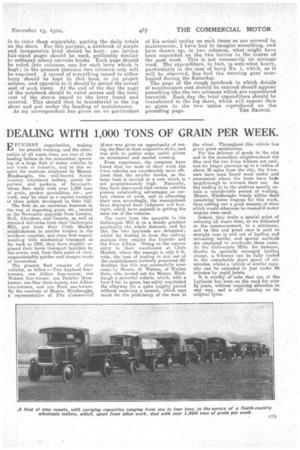DEALING WITH 1,000 TONS OF GRAIN PER WEEK.
Page 13

If you've noticed an error in this article please click here to report it so we can fix it.
EFFIGIENT organization, making for smooth working, and the elimination of all waste time, are two of the leading factors in the economical operating of a large fleet of motor vehicles in any trade or industry, and in this sespect the methods employed by Messrs. Hindhaughs, the well-known Northcountry wholemeal millers, cereal importers, and packers, of Newcastle, whose fleet deals with over 1,000 tons of grain, packet, specialities, etc., per week, may be cited as a capital example of these points developed to their full.
The firnt do an enormous business in the way of importing grain, etc. landed at y
the Newcastle quayside from i...ondon, Hull, Aberdeen, and wGanada, as well as autward deliveries from their Gallowgate
and from their Cloth Market establishment to smaller traders in the northern counties, and since first experimenting with mechanical transport as far back as 1905, they have steadily replaced their horse transport facilities by the newer, and, from their point of view, unquestionably quicker and cheaper mode of locomotion.
The present fleet consists of nine vehicles, as follow :—Two Leyland. fourtonners, one Albion four-tonnes, one Watson four-tonner, one Daimler threetonner, one Star three-tanner, two Albion two-tonners, and one Ford one-tonner. By the courtesy of Messrs. Hindhaughs, a representative of The Commercial
Motor was given an opportunity of seeing the fleet at their respective tasks, and was able to gather some useful points on economical and careful running.
From experience, the company have found that for most of their work the 4-ton vehicles are considerably more efficient than the smaller lorries, as the large load is carried at a cost which is not proportionately high. Naturally, they have discovered that certain vehicles possess outstanding advantages on cartain classes of work, and in allocating their cars accordingly, the management have displayed keen judgment and foresight, which have assisted in getting the most out of the vehicles.
The route from the quayside to the Gallowgate Mill is on a steady gradient practically the whole distance, and for this. the two Leylands are delegated; whilst for -leading in from the 'railway stations they employ the Daimler and the 4-ton Albion. Owing to the narrow entry to their warehouses at Cloth Market, where the passage is only 6 ft. wide, the task of leading in and out of the establishment formerly presented difficulties, but this was successfully overcome by Messrs. IL Watson, of Walker Gate, -who turned out for Messrs. Hindhaugh a powerful vehicle, which, with a bare 4 ins, to spare, has safely negotiated the alleyway for a quite lengthyperiod without receiving a scratch, which says much for the proficiency of the man at
the wheel. Throughout this vehicle has given great satisfaction.
For the delivery of goods in the city and in the immediate neighbourhood the Star and the two 2-ton Alb ions are used, and for longer journeys up to a radius of about 30 miles from the city, the 4-tonners have been -found most useful and economical where the loads have bedtn largetenough to warrant their use. As the leading in to the stations usually entails a considerable period of waiting, Messrs. Hindhaughs wisely utilize their remaininehorse wagons. for this work, thus cutting out a good amount of time which would otherwise be wasted if motor wagons were used.
Indeed, they make a special point of reducing all waste time, as we indicated at the commencement, to a minimum, and to this end great care is paid to straight runs in and out of loading and unloading berths, and special method's are employed to accelerate these tasks. At the Gallowgate Mills. for instance, thanks to specially arranged loading chutes, a 4-tonner can be fully loaded in the remarkable short space of six minutes, whilst a vehicle of similar capacity can be unloaded in just under 26 minutes by rapid hoists.
It is worthy of 'note that one of the Leylands has been,on the road for over 2i years, without requiring attention in any way, and is still running on ita original tyres.


































